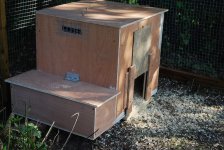dinosaw
New member
- Joined
- Aug 12, 2011
- Messages
- 1,659
- Reaction score
- 0
I built this for the bantams on Saturday morning out of one sheet of marine ply and two battens, oh and 3 hinges from Wilkos. The second batten hasn't actually been used yet and will provide the legs and perches when the chicks have grown a bit. It is flat roofed as it isn't likely to get wet inside the run but to be fair all you would need to do is taper the sides and use half a sheet of onduline on the lid if you wanted it to go outside. Has two nest boxes and space for two perches and would accommodate 8 bantams though originally built it with 5 in mind, opens with a hinge at the back for cleaning. It would be ok for 3-4 large fowl. It is mkIII of a design I have been producing for a few years, they are nice and warm with minimal gaps for red mite to hide in and they do work well for the chickens even if they are absolutely pig ugly to look at, well what would you expect at the price?.
Too much time on my hands + too much caffeine = too many posts on the poultry forum.
Too much time on my hands + too much caffeine = too many posts on the poultry forum.

